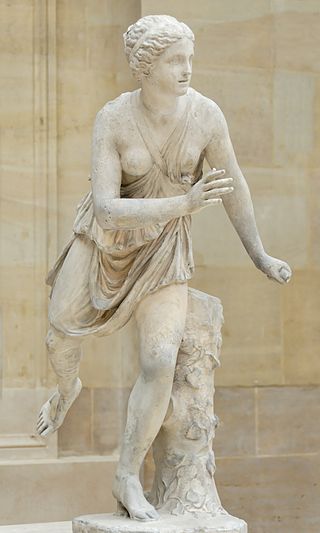
Atalanta is a heroine in Greek mythology.
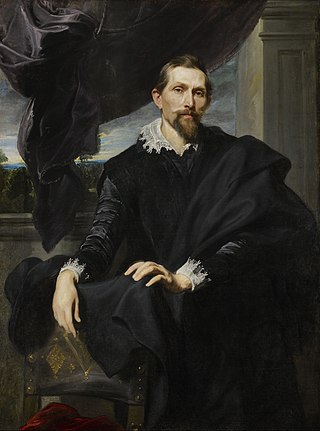
Frans Snyders or Frans Snijders was a Flemish painter of animals, hunting scenes, market scenes, and still lifes. He was one of the earliest specialist animaliers and he is credited with initiating a wide variety of new still-life and animal subjects in Antwerp. He was a regular collaborator with leading Antwerp painters such as Peter Paul Rubens, Anthony van Dyck, and Jacob Jordaens.

The Honeysuckle Bower is a self-portrait of the Flemish Baroque painter Peter Paul Rubens and his first wife Isabella Brant, executed c. 1609.The couple is seated in fine clothes within a garden composition and a vine of honeysuckle is placed overhead. The symbolism of the double-portrait alludes to meanings of love and marriage, such as the holding of right hands, and the concept of the garden of love. The pose of the two figures and their fine clothing signify self-fashioning by Rubens. They wed in 1609, the same year that work was created; it was ultimately given to Isabella’s father Jan Brant and would later end up in the collection of Johann Wilhem II of Düsseldorf. The couple would be married for seventeen years, and have three children before Isabella died in 1625. Her death would have a profound impact on Rubens and through his loss he created an posthumous portrait.

Peter Snayers or Pieter Snayers (1592–1667) was a Flemish painter known for his panoramic battle scenes, depictions of cavalry skirmishes, attacks on villages, coaches and convoys and hunting scenes. He established his reputation mainly through his topographic battle scenes providing a bird's eye view over the battlefield. He further painted large landscapes and portraits of the aristocracy. He was a regular collaborator of local landscape painters and also Rubens.
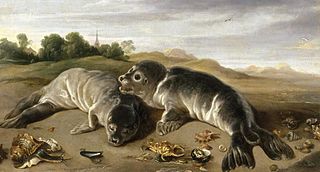
Paul de Vos was a Flemish Baroque painter who specialized in mainly in compositions of animals, hunting scenes and still lifes. He worked for an elite clientele and was a regular collaborator of leading Antwerp painters such as Anthony van Dyck and Peter Paul Rubens.

Flemish Baroque painting was a style of painting in the Southern Netherlands during Spanish control in the 16th and 17th centuries. The period roughly begins when the Dutch Republic was split from the Habsburg Spain regions to the south with the Spanish recapturing of Antwerp in 1585 and goes until about 1700, when Spanish Habsburg authority ended with the death of King Charles II. Antwerp, home to the prominent artists Peter Paul Rubens, Anthony van Dyck, and Jacob Jordaens, was the artistic nexus, while other notable cities include Brussels and Ghent.
The Lion Hunt may refer to:

Sir Peter Paul Rubens was a Flemish artist and diplomat. He is considered the most influential artist of the Flemish Baroque tradition. Rubens's highly charged compositions reference erudite aspects of classical and Christian history. His unique and immensely popular Baroque style emphasized movement, colour, and sensuality, which followed the immediate, dramatic artistic style promoted in the Counter-Reformation. Rubens was a painter producing altarpieces, portraits, landscapes, and history paintings of mythological and allegorical subjects. He was also a prolific designer of cartoons for the Flemish tapestry workshops and of frontispieces for the publishers in Antwerp.

The Hippopotamus and Crocodile Hunt is an oil painting on canvas by Peter Paul Rubens. It was commissioned in 1615 to decorate Schleißheim Palace, along with three other works depicting lion, wolf, and boar hunts. The cycle of paintings was looted from the palace during the Napoleonic Wars. Only the Hippopotamus and Crocodile Hunt was returned to Munich, at which time it was added to the collection that is now the Alte Pinakothek.

The Hunt is a painting created in 1911 by the French artist Albert Gleizes. The work was exhibited at the 1911 Salon d'Automne ; Jack of Diamonds, Moscow, 1912; the Salon de la Société Normande de Peinture Moderne, Rouen, summer 1912; the Salon de la Section d'Or, Galerie La Boétie, 1912, Le Cubisme, Musée National d'Art Moderne, Paris, 1953, and several major exhibitions during subsequent years.

The Tiger Hunt is a large painting by Peter Paul Rubens, featuring a hunt for a tiger. It dates to between 1615 and 1616 and is one of the four hunting paintings, commissioned by Maximilian I, Elector of Bavaria to decorate the old Schleissheim Palace. The cycle was seized during the Napoleonic Wars and this painting is now in Musée des Beaux-Arts de Rennes.

Hercules's Dog Discovers Purple Dye or The Discovery of Purple by Hercules's Dog is an oil painting by Flemish artist Peter Paul Rubens painted circa 1636, towards the end of his career. It depicts the mythical discovery of Tyrian purple by Hercules and his dog, and was one of dozens of oil on panel sketches made by Rubens for the decoration of the Torre de la Parada in Spain. A completed painting based on Rubens's sketch was made by Theodoor van Thulden in 1636–1638, and is now held by the Prado Museum.
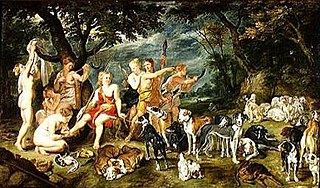
Diana and Her Nymphs Leaving for the Hunt is a 1623–1624 oil on panel painting by Peter Paul Rubens (figures) and Jan Brueghel the Elder. Diana It is now in the Musée de la Chasse et de la Nature in Paris. During his life, Rubens hoped to encourage the painting of classicist hunting scenes.

The Wolf and Fox Hunt is an oil-on-canvas painting by Peter Paul Rubens, executed c. 1616, now held in the Metropolitan Museum of Art in New York. It shows mounted and walking hunters chasing two wolves and three foxes. It marks the beginning of an intensive creative phase in which Rubens focused on the theme of hunting.

The Lion and Leopard Hunt or The Lion Hunt is a painting by Peter Paul Rubens, now held in the Gemäldegalerie Alte Meister in Dresden, Germany. It is very similar to his The Tiger Hunt from the Museum of Fine Arts of Rennes and its dating is debated.
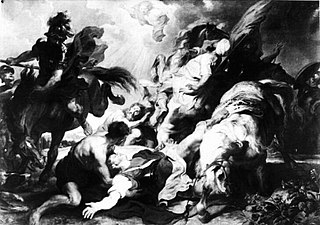
The Conversion of Saint Paul is a 1620s painting by Peter Paul Rubens, now missing or lost. It showed the conversion of Paul the Apostle.
Martin Warnke was a German art historian.

The royal Lion Hunt of Ashurbanipal is shown on a famous group of Assyrian palace reliefs from the North Palace of Nineveh that are now displayed in room 10a of the British Museum. They are widely regarded as "the supreme masterpieces of Assyrian art".

In 1635, Peter Paul Rubens created Venus and Adonis, now in the Metropolitan Museum of Art, New York. He followed the mythological story in the Metamorphoses by Ovid, inspired from his love of classical literature and earlier depictions of this scene. This oil on canvas painting shows Venus accompanied by Cupid, embracing and pulling Adonis before he goes off to hunt. The artist uses specific colors, detail and strong contrast between light and dark to depict a dramatic and emotional scene. At the time Rubens created the painting, the mythological story of Venus and Adonis was popular in Renaissance and Baroque court art. Rubens was clearly inspired by the many existing depictions of this scene, in particular the famous Titian composition of the same name, of which there are numerous versions. This depicts the same moment of Adonis leaving Venus to hunt, despite her pleas to stay. He is killed later in the day.

The Lion Hunt is a series of oil on canvas paintings produced by the French artist Eugène Delacroix in the mid-1800s.






















